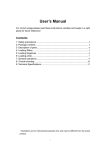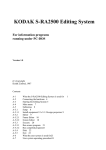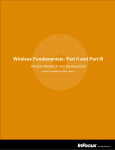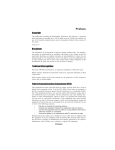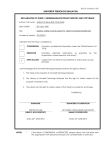Download Projector device user interface system
Transcript
US 20050110953A1 (19) United States (12) Patent Application Publication (10) Pub. No.: US 2005/0110953 A1 Castaldi et al. May 26, 2005 (43) Pub. Date: (54) PROJECTOR DEVICE USER INTERFACE Related US. Application Data SYSTEM (76) Inventors: Joseph Castaldi, West Linn, OR (US); Robin F. Hoeye, Conby, OR (US); Mark Porter, Portland, OR (US); Karla Fisher, Gaston, OR (US); Kevin Thompson, Salem, OR (US); Jennifer Ja?'e, Portland, OR (US); Susan Michalak, Portland, OR (US); Leon Dagler, Sherwood, OR (US); Steven T. Hampson, Lake Oswego, OR (US); Sonia Carver, (US); Greg Kim, Portland, OR (US) (63) Continuation-in-part of application No. 10/033,474, ?led on Dec. 26, 2001, now Pat. No. 6,830,340. (60) Provisional application No. 60/474,501, ?led on May 29, 2003. Publication Classi?cation (51) (52) Int. Cl.7 ................................................... .. G03B 21/26 US. Cl. .............................................................. .. 353/30 ABSTRACT (57) Correspondence Address: KOLISCH HARTWELL, RC. 520 SW. YAMHILL STREET SUITE 200 PORTLAND, OR 97204 (US) (21) Appl. No.: 10/858,670 (22) Filed: Jun. 1, 2004 A method for interfacing a device to a projector is disclosed, wherein the method includes identifying a network to which the device is connected, identifying at least one projector on said network, identifying status of said at least one projector, enabling selection of said at least one projector based on said identi?ed status, and transmitting data to said at least one projector depending on whether it is selected. 61 56 58 10 I‘? / i / 14 E / 65 / j \ . \ 12 so E \ \ \ 1i Patent Application Publication May 26, 2005 Sheet 1 0f 14 10 16 3O 15 US 2005/0110953 A1 14 18 36 / e / 0CD 00300 000 0 . E E8 65 j l Patent Application Publication May 26, 2005 Sheet 2 0f 14 US 2005/0110953 A1 WINDOWS USER INTERFACE SCREEN a EIEHZ] 66 PROJECTOR 1 72 _ \\___ I // MY PRESENTATIONS FILE 76 I \‘ LAN2 /78 WAN " 10 / 74 14 65 // / / 5 \ 12 \ \ SERVER - USER \ DEVICE~ '‘ \ 8O 82 FIG. 4 2 e7 Patent Application Publication May 26, 2005 Sheet 4 0f 14 US 2005/0110953 A1 l2] The selected proiector "[projector name]" is out of range or turned off. Make sure it is in range and turned on, then try again. 0K Help E] The selected projector "[projector name]" is currently in use. Please try again later. Patent Application Publication May 26, 2005 Sheet 5 0f 14 US 2005/0110953 A1 Q Presenter Manager El @IZ] Select your projector in the list below and click Projectl. Projector IlD Number lStatus A Dragonfly 12A34B Available 3 The Boss Project This 89G73C 82E32P Available In Use Erojec? 8 —°a" Settings... V Hide Preferences Help Close — Preferences Resolution While Projecting Low r1 High (Better Performance)l Y , (Better Image) I2] List the last 5 projectors I've used M Enable encryption while I'm projecting E] Automatically launch Presenter Manager when I turn on my computer ,@ Turn off other application alert messages, like meeting notices, while I'm projecting El Turn off my screen saver while I'm projecting t This checkbox may be turned moved to - FIG . 8 Projector Manager. Network name may be here also. Device ID: Y38N27 Projector Model: LP65O FIG. 9 I Patent Application Publication May 26, 2005 Sheet 6 0f 14 User launches Mgr US 2005/0110953 A1 . which takes a snapshot ‘ Lagiestgzliitzzjsré? of user's current WLAN settings ' User clicks ‘ a ear in list pp 1003 Scan button ' No projlescit'or in Yes ‘ '“ Alert: No other projectors are available. \ 1020 Alert warns user s/he will lose current network Cancel “ connectivity. 1021 / name & ID number in list with Is desired 1018 / 1019 User compares 0K Mgr. scans all IBSS networks. 1022 / Detect From From other rojectors Fig.10B Fig.10B '? 1023 Present other projectors in list 1024 / FIG. 10A F|g 10B Patent Application Publication May 26, 2005 Sheet 7 0f 14 US 2005/0110953 A1 1 004 From ; |_S it 'Avallable'? Yes User highlights it and clicks "Project!" button 1006 / Desired projector's User Statushighlights is 'Unknown.‘ it and clicks "Project!" button. To To Fig.1OA Fig.1OA A projector is grayed out in 1008 / A Alert warns user s/he will lose current network Cancel 1010 connectivity. / loK Progress dlog (Fig. 15) 7 Alert appears saying that , OK desired projector is either out of range or turned off. projec e onscreen‘ 1012 / OK . Use.r stdgsktop '5 1014 / I that When done, user clicks "Stop Projecting" . . desired projector is in use and closes apphcatlon' Alert appears saying 1017 / 1015 1 FIG. 10B Previous WLAN settings are restored 1016/ Patent Application Publication May 26, 2005 Sheet 8 0f 14 US 2005/0110953 A1 q. v6_v2um6.0m| wm569E2o3m>a .@E2m85~3>5 2E3E0563.:520.%,:a5> 26533055?km585.2m805%:>i 62835Enn.m9o%2ac? ca2:5m5296:9:22.m6E589:3653: 2ES2?5 .me:22 ? o6x.w52_:m65.z0 Patent Application Publication May 26, 2005 Sheet 10 0f 14 US 2005/0110953 A1 Installing Over Newer Version l3] Some selected projectors have a newer :: version of the Presenter ?rmware. Are you sure you want to install the older version? OK LCancel I FIG. 13 Installing over Newer Version Alert Patent Application Publication May 26, 2005 Sheet 11 0f 14 US 2005/0110953 A1 _ D mm xomm$626vA260 .UE3 .2wEQGm5BoShE2w3aoQ >mEQ=wncohmno5i m:[email protected]?8;Em35:9> L9EwmN_g>E: 98E3:F05u2ioE a3$g i03n: 938$:563095 m8$0u5n:m;>0 H Patent Application Publication May 26, 2005 Sheet 12 0f 14 Presenter Module Update Status Dragon?y LightStream Starship Enterprise Resetting In Progress Queued Yadda Yadda Queued US 2005/0110953 A1 Percent Complete 100% 70% 0% A ;! 0% V FIG. 15 Presenter Module Update Status Dragon?y LightStream Starship Enterprise Updated Resetting In Progress Yadda Yadda Queued Percent Complete A 100% 100% 70% :1 0% V FIG. 16 Patent Application Publication May 26, 2005 Sheet 13 0f 14 US 2005/0110953 A1 60:8 D SE M $83W@9825:03 629$@cQ3850m21>3 283@:95:3 $“8w@25;8>3 2 3 8 0 m : 5 9 e 6 3 5 8 m536w2Q9ES:8mu.3o;51: .2E9m5~3$> £@25". =86$z.2é39w<mo8;as:w May 26, 2005 US 2005/0110953 A1 PROJECTOR DEVICE USER INTERFACE SYSTEM CROSS-REFERENCE TO RELATED APPLICATIONS [0001] The present application claims domestic priority under 35 U.S.C. § 119 to US. Provisional Patent Applica tion Ser. No. 60/474,501, Which Was ?led on May 29, 2003. The disclosure of that application is hereby incorporated by reference in its entirety for all purposes. The present appli cation is also a continuation-in-part of, and claims the bene?t of, US. patent application Ser. No. 10/033,474, Which Was ?led Dec. 26, 2001. The disclosure of that application is hereby incorporated by reference in its entirety for all purposes. present issues to the presenter. For example, there may be compatibility issues betWeen the hardWare and softWare on the computer and on the image projector. Moreover, con nection to the image projector may require numerous cables and/or adapters to enable connection of the user’s computer With the available projector. It is not unusual for the cables and adapters to get lost or become misplaced. [0013] Thus, Where cables are used to connect image sources directly to a projector, there may be issues When multiple presenters use the same projector. For example, When transitioning from a ?rst presenter to a second pre senter, the ?rst presenter must physically connect an image source, such as a computer, to an image projector using the appropriate adapters and cables. The ?rst presenter then TECHNICAL FIELD [0002] The present disclosure relates generally to a user interface and related system for a projection device. typically seats himself or herself close to the image projec tor. When the second presenter Wants to present their pre sentation, the ?rst presenter may have to disconnect the computer from the image projector, enabling the second presenter to connect a neW computer to the image projector, BRIEF DESCRIPTION OF THE DRAWINGS [0003] The disclosure is illustrated by Way of example and not by Way of limitation in the ?gures of the accompanying draWings, in Which the like references indicate similar elements and in Which: [0004] FIG. 1 is an exploded isometric vieW of an image projector and an image-rendering device according to one embodiment. [0005] FIG. 2 is a graphical representation of an exem plary use environment in Which the embodiment of FIG. 1 may be implemented. [0006] FIG. 3 is a representative user interface for the system depicted in FIG. 1, shoWing an embodiment of a projector selection WindoW. [0007] FIG. 4 is a schematic diagram of another exem plary use environment in Which an example embodiment may be implemented. [0008] FIGS. 5-8 and 11-18 are example WindoWs that may be provided on a user’s device interfacing With a possibly using different adapters and cables. Typically, the ?rst presenter may have to change seats With the second presenter to provide room for the second presenter to connect to the image projector. This transition betWeen the ?rst and second presenter may take a signi?cant period of time and be disruptive to a meeting. [0014] To address at lease some of these issues (or others), an image rendering device can be used that is con?gured to connect to (either Wirelessly or via a Wire) and receive image data from many different types of image sources, to render images from the data, to communicate With the image sources and peripheral devices, and to perform these func tions With reduced input and effort from a user. [0015] This disclosure includes various example user interface systems for use With an image transmitting/receiv ing/rendering device and an associated projector device. The user interface may be con?gured to alloW a user to control the image transmitting/receiving/rendering device, and to utiliZe the image transmitting/receiving/rendering device to control the presentation of content by, and administrative aspects of, the associated projector device. The disclosed projector. user interface systems may be implemented in many differ [0009] FIG. 9 is an example splashette image generated ent use environments. Also, the disclosed user interface by a projector at selected conditions. systems can be simple enough for inexperienced users to use yet includes capabilities permitting experienced users to [0010] FIG. 10 is an example How chart illustrating opera access advanced features. tion of an example user interface system. DETAILED DESCRIPTION [0011] In recent years, projector devices, such as digital projectors, have found increased popularity as a tool for the presentation of content to an audience. These projectors are typically used to project a computer-generated presentation onto a vieWing surface, and alloW a user to easily present [0016] The disclosed projector device user interfaces may include several individual components. These may include, but are not limited to, an installer, a presentation manager (con?gured to manage the presentation of an image by the associated projector device), a projector manager (con?g ured to manage the administrative aspects of the associated projector device), an uninstaller, and online help documen high-quality, professional appearing images to audiences of tation. Various features of these components are described in a range of siZes. As a result, these projectors are noW often found as permanent ?xtures in conference rooms and other vieW of the user interface by describing particular imple mentations in WindoWs and/or Apple OS X environments, meeting facilities. more detail beloW. While the disclosure provides an over any environment may be used, such as PALM or other PDA [0012] Some projector devices are con?gured to enable a user to access a presentation by coupling their computer to the projector. Typically, a user must physically connect their computer, such as a personal computer or personal digital operating environments, and as such the present disclosure provides some operational details common to any operating system environment. Further, the term “Presenter” is used to assistant (PDA), to the image projector. This process may but not limited to the image source (e.g., a computing describe the overall image presentation system, including May 26, 2005 US 2005/0110953 A1 device), the presenting device (eg a digital projector), and any image compression/decompression/transmission hard [0022] Image-rendering device 14 further may include at least one peripheral device connector 36 on body 15. Periph ware, ?rmware, and/or software associated with these devices. peripheral device to be operably linked to image-rendering [0017] The disclosed user interface system may be used with any suitable image transmitting/receiving/rendering device and associated projector device. An example a suit able device is described below with regard to FIGS. 1, 2, and 4. [0018] Referring now speci?cally to FIG. 1, an image display system is shown generally at 10. Image display system 10 typically includes an image projector or visual presentation projector 12 and an image-rendering or image transformation device 14. Brie?y, image-rendering device 14 is operably coupled to, or otherwise operably associated with, image projector 12, such that images are transferred from image-rendering device 14 to image projector 12 for presentation on a projection or viewing surface. Image rendering device 14 is adapted to receive images from a eral device connector 36 is con?gured to enable at least one device 14 to enable images to be transferred from a periph eral device to image projector 12 or vice versa. Peripheral connector 36 may be any suitable connector. For example, peripheral connector 36 may be a standard connector, such as a Universal Serial Bus (USB) port, IEEE 1394 port, parallel port, e.g. enhanced parallel port (EPP), extended capabilities port (ECP), etc. It should be noted that more than one peripheral connector may be provided on body 15. Further image-rendering device 14 may also include a light, such as a light emitting diode (LED) 30, which can be used for diagnostic functions, described in more detail below. Alternatively, the LED 30 may be located as the projector, such as in the example when image-rendering device 14 is internally located in projector 12. plurality of different sources and is further adapted to [0023] In an alternative embodiment, selected functions and selected components of image-rendering device 14 may automatically transmit a projectable image-to-image projec be integrally formed within projector 12. tor 12. Image-rendering device 14 may also be referred to herein as “image-rendering module” or “presenter module.” which image-rendering device 14 may be implemented. [0019] Image projector 12 may be any suitable display device, including, but not limited to, liquid crystal display (LCD) projectors, digital light processing (DPL) projectors, [0024] FIG. 2 illustrates an exemplary use environment in Speci?cally, image-rendering device 14 is shown in a net work environment 61. Network environment 61 may include a plurality of different devices, such as computers, laptops, etc. servers, handheld computers, etc. The insertion of an appro [0020] The depicted image-rendering device 14 includes a body 15. Body 15 is con?gured to be selectively inserted at priate network card into image-rendering device 14 may least partially within an attachment slot 17 in image projec tor 12. Speci?cally, body 15 includes a projector connecter 16. Projector connector 16 functions to couple image-ren dering device 14 to image projector 12. Projector connector 16 further functions to transmit or transfer a projectable enable presentation content on each of the network devices to be selectively transmitted to image-rendering device 14 for display by image projector 12. As shown, image projec tor 12 may display the transferred image onto a display surface 65. [0025] In one embodiment, a splashette function may be image-to-image projector 12. As illustrated in FIG. 1, pro included in the device 14 and/or projector 12. The splashette jector connector 16 may include a plug 18 that is adapted to be received into a corresponding outlet 20 in image projector corner of the screen (although other locations can also be 12, permitting image-rendering device 14 to directly engage or plug into image projector 12. Attachment structures, may include a small window that appears in the upper right selected) at selected conditions, such as start-up/power-up. The rest of the screen may consist of a black background, for including latches 22, projections, pins, tabs, braces, screws example. The splashette may contain various items and/or or other suitable supports, may be used to retain image information, which are described in more detail below rendering device 14 within outlet 20. Alternatively, instead herein with regard to FIG. 9. of an integral connector, projector connector 16 may be attached to projector 12 in a remote fashion via a cable and [0026] As described above, the network interface card suitable plug. [0021] Body 15 of image-rendering device 14 may include card. Alternatively, projector 12 may include wireless or at least one image receiver con?gured to receive a plurality of different data transfer devices. Data transfer devices may enable image-rendering device 14 to receive images from multiple sources. A data transfer device may be a card, an expansion board, an adapter or other suitable device. For example, a data transfer device may be a network interface card, such as a wired network card, or a wireless network card (eg a wireless LAN card, such as IEEE 802.11a, 802.11b, 802.11g, 802.11x, a radio card, a Bluetooth radio card, a ZigBee radio, etc.). In one example, a network interface card may enable communication between device 14 and an independent source, eg a remote computer, server, network, etc. This communication may allow an image or presentation stored on the independent source to be transmitted to image-rendering device 14 after the indepen may be either a wireless network card or a wired network wired network capability integrally formed in the projector unit. It should further be appreciated that a wireless network card may be permanently integrated within image-rendering device 14. The wireless network card may enables a plural ity of users to alternatively link to the local area network and send images/presentations to an image projector without individually having to manually couple their computer to a projector. Additionally, as long as a user’s computer device is capable of linking to the local area network using standard protocols and transferring data, the type and model of the computer linked to device 14 may be irrelevant. No adapters or cables are necessary for the wireless connection (although they could be used, if desired). Thus, users may be able to present from any location in a room, or remote from the room. dent source identi?es and selects projector 12, as described [0027] in more detail below. ing room environments, where multiple individuals using Such a system may be particularly useful in meet May 26, 2005 US 2005/0110953 Al the same projector system for presentations may be using different formats. For example, an image ?le corresponding different operating systems and/or platforms. For example, to the appearance of the display on the user’s computer (screen shots or scrapes) may be sent to device 14. Image data may also be transferred in other formats using a reduced amount of transmission bandWidth, if desired. in FIG. 2, ?ve computers (tWo portable computers or laptops 56 and 58, a desktop computer 60, a handheld computer 62, and a telephone 64) are shoWn linked to device 14 over a Wireless LAN. Any of the users may link to image projector 12 via image-rendering device 14 Wirelessly. Usu ally, the user Who is presenting or the active presenter releases or exits from the currently active presentation to enable a second presenter to begin sending data to device 14 for presentation. [0028] It should be understood that any suitable computer or computing device that may be capable of Wirelessly linking to the local area netWork and conveying an image, or the URI or other indicator of the location of an image, to device 14 may be used. Computers, as used herein, include, but are not limited to, desktop computers, handheld com [0032] It should be noted that in some embodiments, the user’s computer may send the image data directly to image rendering device 14. Alternatively, the user computer may send data including a universal resource indicator (URI) to image-rendering device 14, Which directs device 14 to the appropriate location to pick up the desired image/presenta tion. [0033] As discussed above, a Wired netWork card also may be received Within the image receiver. It Will be appreciated that a Wired netWork card also may be permanently inte grated Within image-rendering device 14 Without departing puters, laptop computers, servers, mainframes, telephones, from the scope of the present disclosure. etc. [0034] An exemplary netWork environment is shoWn in FIG. 4. As illustrated, image-rendering device 14 may be [0029] Device 14 enables the transfer of data to image projector 12 by connecting a user’s computer With an image projector. In some embodiments, device 14 may communi connected directly to a LAN 74 via a Wired and/or Wireless netWork card. Image-rendering device 14 may be further linked to a second LAN 76 and/or a WAN 78, such as the cate the name of the projector to Which it is coupled to the user’s computer, While also projecting the name onto screen Internet, through LAN 74. Image-rendering device 14 also 65 When the projector is initially poWered on. Thus, When a may be able to connect to a remote server 80 or user 82 via LAN 74. Such a con?guration may enable a user to run a user connects to a netWork on Which the projector is located, the project may appear as an icon, or be added to a list of presentation on image projector 12 from a remote location. projectors to Which the computer may be connected. In this situation, the user may select the projector from the list of projectors to connect to a speci?c image projector. An [0035] It should be noted that image-rendering device 14 may be compact and portable. Typically, image-rendering exemplary user interface is shoWn in FIG. 3, as Well as FIGS. 5-8, and 10-18. The exemplary user interface of FIG. 3 includes a selection WindoW 66 for display on a computer screen 67, but other formats are possible. The user interface may include a projector icon 68. Such an icon may be used to identify the projector that is currently available on the netWork. For example, and as shoWn in FIG. 3, “Projector 1” is linked to the user’s computer via device 14. Alterna tively, a user may be able to select the desired projector from a list of projectors 70. [0030] The user interface also may include a presentations ?le 72 con?gured to alloW a user to store presentations or images for display. When a user desires to present a pre sentation, a local Wireless netWork card may be inserted into an image receiver Within image-rendering device 14. The name or identi?er for the linked projector may then be broadcast to the user’s computer indicating that the user can connect to the image projector and send images and/or device 14 may be much smaller and lighter than a conven tional laptop. Moreover, no user input device, such as a keyboard or mouse, is necessary (although one can be included if desired). The device can be an automatic ren dering engine con?gured to automatically render and trans mit images from a ?rst source to an image projector for display. [0036] As noted above, a user interface may be used With the system to enable a user to perform various functions, such as transferring and projecting images. While one example user interface Was described above, various others may be used. One such alternative embodiment user inter face may have the folloWing components: an installer, a presenter manager, a projector manager, an uninstaller, and online help documentation. [0037] The installer may be used to Walk the user through installing softWare[]necessary to use a presenter module, Which controls operation such as giving presentations from presentations to device 14. The user may then select a a user’s computer over a Wireless netWork to a projector. The presentation from presentation ?le 72 and direct it to the linked projector via projector icon 68. The user does hot need to physically move his/her computer next to image projector 12, nor does the user have to plug adapters or cables into his/her computer to connect to the image pro jector (although the user can, if desired). Instead, the user installer also alloWs users to identify the directory into Which they Would like to install the softWare, choose simply connects to the Wireless netWork and directs a desired image or presentation to the projector. The user may remain seated the entire time and does not need to move to a position near the projector When presenting (although the user may, if desired). [0031] As discussed above, data and/or images may be transmitted from a user’s computer to device 14 in many Whether they Want a desktop shortcut, and automatically launch the user manual and the presenter manager applica tion When the installation is ?nished. It may also offer to test any Wireless PC card provided. [0038] The presenter manager component alloWs the user to select a projector in range, start and stop projecting, and set preferences. It also alloWs the user to adjust the presenter module’s settings—for example, to rename the presenter module and the presenter module’s netWork, to specify the presenter module’s IP address if desired, and/or to reset the presenter module’s settings to factory defaults. This com May 26, 2005 US 2005/0110953 A1 ponent may be decoupled from the presenter softWare—for example, it may be on a presenter install CD. [0039] The uninstaller alloWs the user to easily uninstall the presenter software. [0040] The online help documentation may provide users With easy access to online help. [0041] Referring noW to the presenter manager in more detail, When the user launches the presenter manager oper ating on their computer, for example, a WindoW may open to PC-based devices may be set to approximately 5 beacon intervals (i.e. the time betWeen receiving beacons), While on Mac-based devices the value may be set to approximately 9 beacon intervals, to obtain desired performance. HoWever, in an alternative embodiment, a common listening time may be used for all devices. These values may also be added to the registry on the PC and to a preferences ?le on the Mac so that users With different antennas and in different envi ronments can adjust the values to suit their needs. manager may take a snapshot of the user’s current Wireless [0046] In one example, the MRU list of the last or previ ously used devices may be updated based on Whether a device is successfully used. If so, it may be added to the list. local area netWork (WLAN) settings and populate a list of Further, if the WLAN is the same and no beacons are projectors With projectors and/or image rendering devices detected, the device may stay in the list With an indicated found in the current WLAN as Well as the last ?ve image status of unknown. If the user tries to connect to it and it is not available, an error may be displayed and then the its normal vieW shoWn in FIG. 5. Upon launch, the presenter rendering devices used (MRU, or “most recently used”). The projectors on the current WLAN may be discovered in any suitable manner. Suitable manners of discovering projectors on the WLAN include, but are not limited to, monitoring a multicasit address on the WLAN to Which the projectors projector may be dropped from the MRU list. and/or image rendering devices are con?gured to send [0047] If an available or unknoWn projector is selected, the Project! in the ?gure button may be the default button. The Project! button may be disabled if there are no projec announcement messages, or “beacons,” announcing their tors or devices found, or if there is no projector or device presence and/or availability; and/or receiving broadcast or unicast beacons. Note that While in this example the last ?ve devices used may be included, this is just an example and selected. Note that, in this example, the user may only select appear in the list but may be grayed out. more or less (or none) of the last or previously used devices may be listed. Further details of the operation of the pre senter manager are provided beloW With regard to FIG. 10. [0048] When the user selects an available projector and clicks the Project! button (or hits the Enter key), a screen scrape application starts. When the screen scrape application [0042] As shoWn in FIG. 5, the list of projectors may have three columns: Projector, ID Number, and Status. By default, the primary sort is by status and the secondary sort has started (that is, the user’s desktop has been rendered in the projected image), the button toggles to Stop and the is by projector name, although other sorting approaches may be used, if desired. The ?rst available projector in the list is highlighted by default; and if there are no available projec tors in the list, then the ?rst unknoWn projector is high lighted by default. The user can move the highlight bar by pressing the up/doWn arroW keys, or With the mouse, for example. While the depicted embodiment includes a list of projectors, it Will be appreciated that it may include other types of image display devices in the list. Examples include, but are not limited to, rear projection display devices. [0043] The Status column indicates Whether each projec tor is available, in use, or unknoWn, although other identi ?ers could be used, or only a single identi?er may be used. If a projector is in use, its name may be grayed out (unless it is the projector the user is currently using). If there is only one available projector in the list, it may be selected by default. Aprojector’s status may be unknoWn if it is one of the last 5 projectors used but is not on the current WLAN, for example. an available or unknoWn projector; projectors that are in use status of the selected projector or device ?ips to indicate that is it in use. HoWever, unlike projectors that are in use by others, Which are grayed out, the projector the user is using does not become grayed out. [0049] If there is a lag betWeen clicking the Project! button and the appearance of the projected image, the user may see some visual feedback that the softWare is responding to the button press. If the lag is only tWo seconds, holding doWn the Project! button for a second Would give the user feed back that something is happening and may prevent them from clicking the button again. If the lag is longer than tWo seconds, some other feedback may be provided—for example, text in the loWer right corner of the screen may be used Which states, “Establishing Wireless link. Please Wait.” [0050] If the user selects a projector With a status of “unknoWn” and clicks the Project! button, an alert dialog may be provided to notify the user that current netWork activities may be disrupted While the program looks for available devices Or projectors, and that the user should close any applications using ?les on the netWork. Proceed A projector may be dropped from the list When a ing past this point dismisses the dialog and replaces it With beacon is no longer heard and the WLAN settings are the a progress dialog that may be used to indicate progress in the search. [0044] same as When last checked and an attempt to connect to that projector has failed. OtherWise, the projector is left in the list and is unknoWn. HoWever, a user may also drop a projector [0051] One of three things may then happen (When the from the list manually. user selects a projector or device Whose status is unknoWn): [0045] Note that there may be issues With listening for range or turned off), Which may generate an alert dialog as beacons and adding/dropping devices to the list based on the beacon. For example, a value that is too short may result in Which generates an alert dialog as shoWn in FIG. 7, or (3) projectors ?ashing in and out of the list. Alternatively, a value that is too long may result in inaccurate status. the projector is found and is available, Which projects the contents of the user’s desktop (or some other selected ?le) Therefore, in one example, the time to listen for a beacon on on screen. (1) The projector or device cannot be found (e.g., it is out of shoWn in FIG. 6, (2) the projector is found but is in use, May 26, 2005 US 2005/0110953 A1 [0052] The Scan button may be enabled unless the user is currently projecting. Clicking the Scan button may also cause an alert dialog, followed by a progress dialog as described above. If more presenter-enabled projectors or devices are found, they may also appear in the list. If no more presenter-enabled projectors or devices are found, the System Left PC Mac progress dialog may be replaced by a dialog Which states Middle Right 800 x 600 x 16 1024 x 768 x 16 1024 x 768 x 24 bit color bit color bit color 800 x 600 x 1024 x 768 x 1024 x 768 x thousands of colors thousands of colors millions of colors that no more presenter-enabled projectors or devices Were found. [0053] A Settings . . . button may be enabled When an available projector or device, or the projector or device the user is currently using, is selected. Clicking it opens a settings dialog, Which may alloW the user to adjust various settings, such as, for example: the presenter name, netWork name, and IP address (the user can either choose to obtain an IP address automatically or specify the IP address, net mask, and gateWay). The presenter module’s MAC address may also be provided as read-only information. The Settings . . . button is still available When projecting, but all content of the settings dialog may be read-only to reduce disruption of a presentation. Adiagnostics tab may also be provided Which [0057] The slider thumb can default to any tick, such as the middle tick. The user can then move the input focus to the resolution slider by pressing Ctrl-R and use the right and left arroW keys on the keyboard to move the slider’s thumb back and forth, or using a mouse. The selection on the resolution slider is invoked When the user projects and, When the user stops projecting, the user’s previous display reso lution setting (if different) may be restored. Whenever the desktop display is about to change from the user’s current display setting, an alert dialog may appear When the user clicks the Project! button. For example, the alert dialog may appear if the user’s system is in an unsupported resolution (e.g., 1400x5200) or if the user has changed the selection on the slider and it is noW different from the user’s current may enable a user to blink LED 30 on a projector or image display setting. rendering device to verify a proper connection, and/or restore factory settings. The diagnostics tab may also illus trate the LED location on the projector or device, such as on [0058] Continuing With FIG. 8, the default state of the checkbox for “List the last 5 projectors I’ve used” is checked. If the user unchecks this box, the last 5 projectors the image-rendering device (30). used—that are not on the current WLAN and are not [0054] Also, from the settings dialog, a passWord can be currently in use—can be removed from the list. Various other default checked boxes are also illustrated, Which may be unchecked by the user. set and used. Users do not have to set a passWord and, by default, there is no passWord. HoWever, any user could select and change an image rendering device module’s settings. If [0059] While FIGS. 5-8 and the corresponding descrip the next time the user opens the settings dialog, all of its tion has described portions of an example user interface, various other approaches may be used. For example, an interface adapted to be used With a Mac system may also be provided. Example changes that may be used are that: the system may automatically provide for a menu bar for any application Which may include a “ShoW Info” feature; the system may take advantage of other features, such as sheet settings and controls are read-only and the passWord is required to make changes. If the user just changes the image controls; or the system may not use right-click mouse button rendering device module’s name, the user Will still be features. communicating With the image rendering device module. If [0060] the user is concerned about others changing the presenter module’s settings, s/he can protect the settings With a passWord. To set a passWord, the user clicks a button in the settings dialog and a passWord dialog appears Which alloWs the user to set and con?rm a passWord. If a passWord is set, the user Was projecting at the time the name Was changed, projection continues and the name updates in the list. If the user Was not projecting, the splashette may update itself With the neW name and the name may also update in the projector manager list. dialogs, the system may used different placement of typical Referring noW to FIG. 9, an example splash screen, or splashette, is described. The splashette may be a small or large WindoW that appears in the upper right corner (or other area) of the screen. The splashette may contain one or more of the folloWing ?elds, or combinations there of: [0061] Name: presenter projector name; [0055] If the user clicks the ShoW Preferences button in the normal vieW, the WindoW may expand and the button toggles to Hide Preferences. The expanded vieW may give [0062] Unique ID: presenter unique ID (Which may the user access to application-speci?c preferences, for [0063] WLAN: presenter netWork name; [0064] Model: projector model; [0065] Version: 1.0.x.x (Which may be in light gray); [0066] IP address (Which may be in light gray); example. The ShoW/Hide Preferences button may alWays be enabled; hoWever, preferences that cannot be changed dur ing projection may still be disabled While the user is pro jecting. FIG. 8 shoWs an example expanded WindoW of the presenter manager. [0056] The resolution slider may provide three or more ticks (or less, if desired). The text in the table beloW may appear in tool tips that appear above each tick mark: be derived from a MAC address); [0067] Note that a USB test may be performed at boot-up that checks for existence of USB communications. If none are found, a star can be used to so indicate.























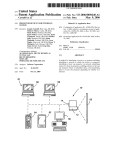
![Page 1 (12) United States Patent Castaldi et a]. US007118220B2](http://vs1.manualzilla.com/store/data/005861806_1-939e513e2a7d3e1f9213dbaf59950ac6-150x150.png)
